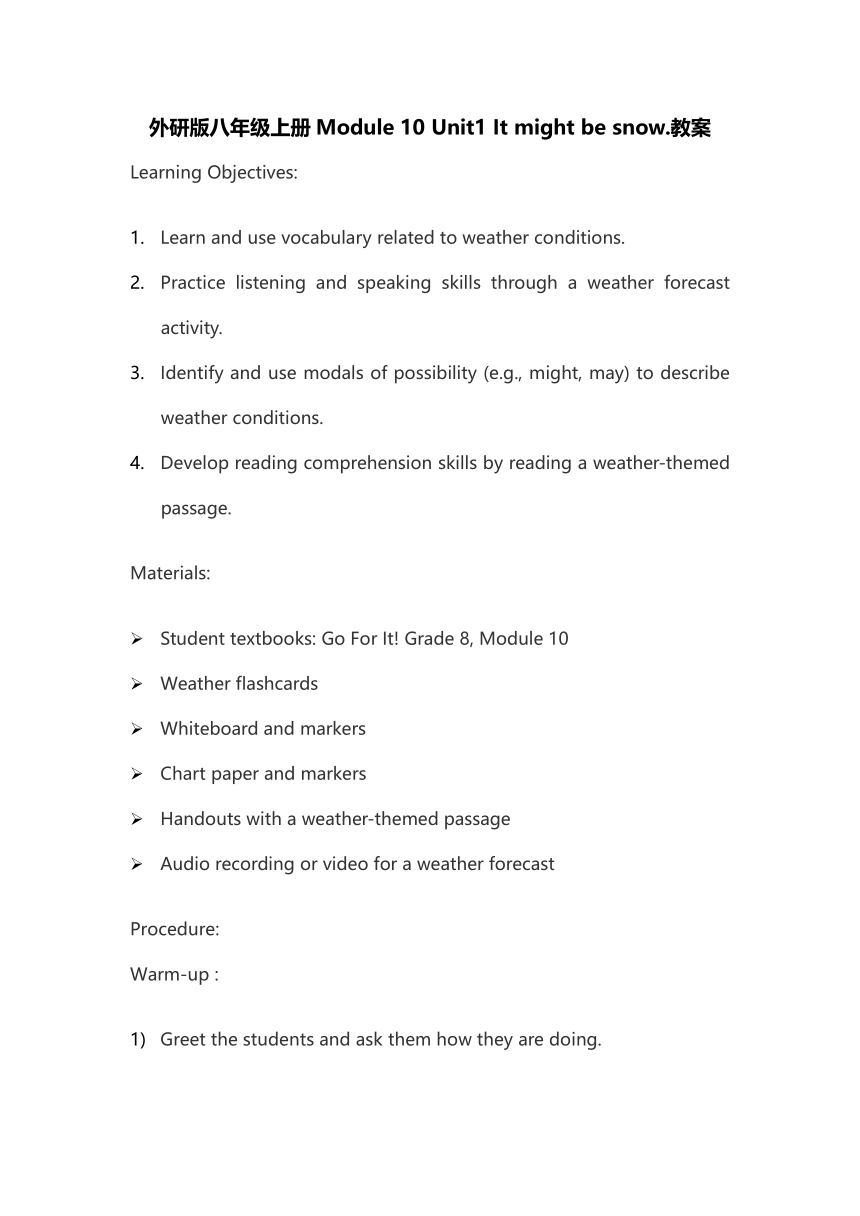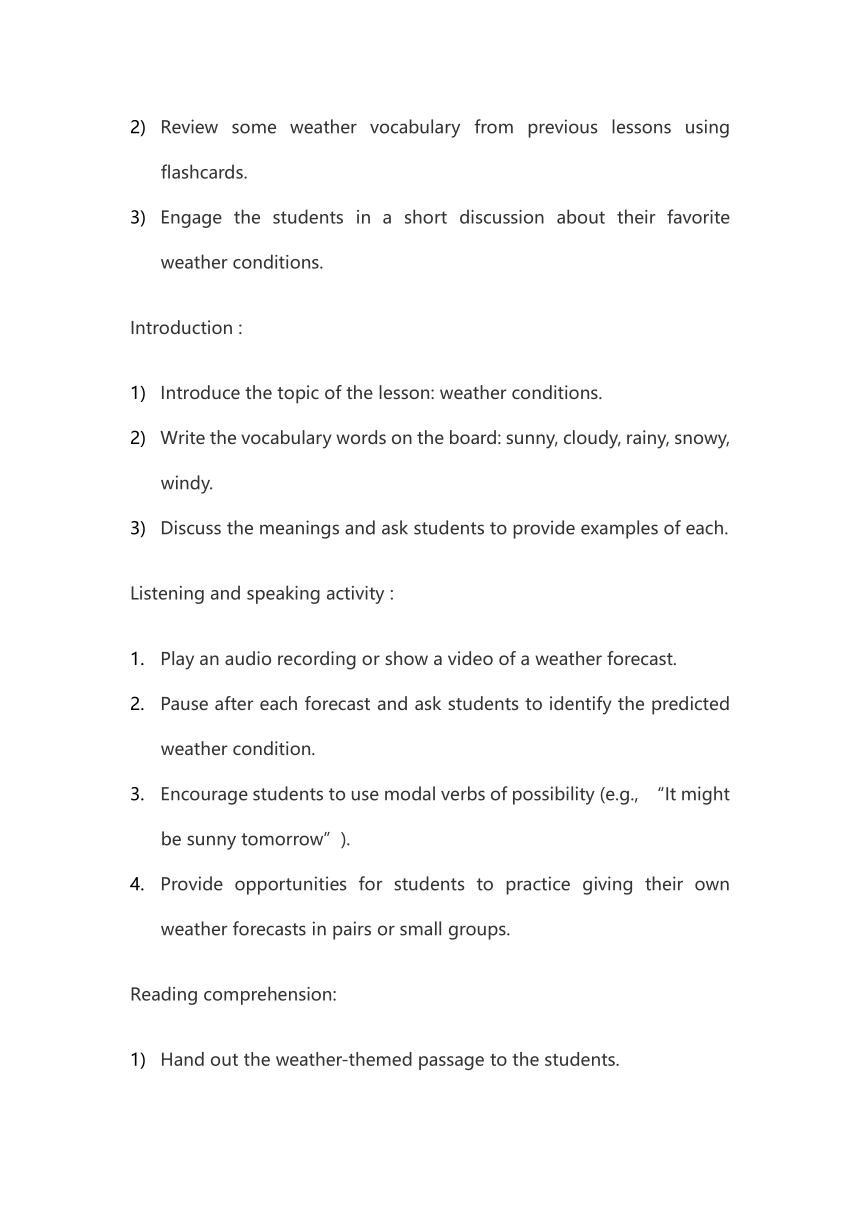Module 10 Unit1 It might be snow.教案 外研版英语八年级上册
文档属性
| 名称 | Module 10 Unit1 It might be snow.教案 外研版英语八年级上册 |  | |
| 格式 | docx | ||
| 文件大小 | 18.5KB | ||
| 资源类型 | 教案 | ||
| 版本资源 | 外研版 | ||
| 科目 | 英语 | ||
| 更新时间 | 2023-07-30 10:48:39 | ||
图片预览


文档简介
外研版八年级上册Module 10 Unit1 It might be snow.教案
Learning Objectives:
Learn and use vocabulary related to weather conditions.
Practice listening and speaking skills through a weather forecast activity.
Identify and use modals of possibility (e.g., might, may) to describe weather conditions.
Develop reading comprehension skills by reading a weather-themed passage.
Materials:
Student textbooks: Go For It! Grade 8, Module 10
Weather flashcards
Whiteboard and markers
Chart paper and markers
Handouts with a weather-themed passage
Audio recording or video for a weather forecast
Procedure:
Warm-up :
Greet the students and ask them how they are doing.
Review some weather vocabulary from previous lessons using flashcards.
Engage the students in a short discussion about their favorite weather conditions.
Introduction :
Introduce the topic of the lesson: weather conditions.
Write the vocabulary words on the board: sunny, cloudy, rainy, snowy, windy.
Discuss the meanings and ask students to provide examples of each.
Listening and speaking activity :
Play an audio recording or show a video of a weather forecast.
Pause after each forecast and ask students to identify the predicted weather condition.
Encourage students to use modal verbs of possibility (e.g., “It might be sunny tomorrow”).
Provide opportunities for students to practice giving their own weather forecasts in pairs or small groups.
Reading comprehension:
Hand out the weather-themed passage to the students.
Instruct them to read the passage individually.
Discuss any unfamiliar vocabulary, and check comprehension by asking questions.
Summarize the main points of the passage as a class.
Class discussion and reflection:
Lead a class discussion about the importance of weather forecasts and how they affect people’s daily lives.
Ask students to share their thoughts on the passage they read.
Encourage students to express their opinions and ask questions.
Conclusion and assessment:
Review the key vocabulary and modals of possibility.
Give a short quiz or assessment activity to test students’ understanding of the material covered in the lesson.
Homework:
Assign students to write a short weather forecast paragraph using the modals of possibility.
Encourage them to use the vocabulary words and sentence structures practiced in class.
Extension Activities:
Divide the class into small groups and assign each group a different weather condition (sunny, cloudy, rainy, snowy, windy).
Instruct each group to create a short skit or role play based on their assigned weather condition. They can act out how people react to the weather and what activities they engage in.
Allow each group to perform their skit in front of the class and have a class discussion afterward about the different scenarios.
Vocabulary Reinforcement:
Create a vocabulary review game. Write the vocabulary words on the whiteboard and divide the class into two teams.
Call out a definition, and the teams compete to correctly shout out the corresponding vocabulary word.
Continue with more definitions until the review game is complete.
Homework Review:
Begin the next class by reviewing the weather forecast paragraphs that the students wrote for homework.
Select a few students to share their paragraphs with the class, and provide feedback and corrections as needed.
Conclusion and Wrap-up:
Recap the key points covered in the lesson, including the vocabulary, modals of possibility, and the importance of weather forecasts.
Provide a brief summary of the activities and discussions that took place during the lesson.
Answer any questions that the students may have.
Evaluation and Assessment:
Throughout the lesson, monitor students’ participation, understanding, and use of vocabulary and modals of possibility.
Observe students’ ability to give weather forecasts and engage in discussions using the target language.
Use formative assessment techniques, such as questioning and listening, to gauge students’ comprehension and progress.
Consider providing feedback and/or a final assessment to measure students’ achievement of the lesson objectives.
Learning Objectives:
Learn and use vocabulary related to weather conditions.
Practice listening and speaking skills through a weather forecast activity.
Identify and use modals of possibility (e.g., might, may) to describe weather conditions.
Develop reading comprehension skills by reading a weather-themed passage.
Materials:
Student textbooks: Go For It! Grade 8, Module 10
Weather flashcards
Whiteboard and markers
Chart paper and markers
Handouts with a weather-themed passage
Audio recording or video for a weather forecast
Procedure:
Warm-up :
Greet the students and ask them how they are doing.
Review some weather vocabulary from previous lessons using flashcards.
Engage the students in a short discussion about their favorite weather conditions.
Introduction :
Introduce the topic of the lesson: weather conditions.
Write the vocabulary words on the board: sunny, cloudy, rainy, snowy, windy.
Discuss the meanings and ask students to provide examples of each.
Listening and speaking activity :
Play an audio recording or show a video of a weather forecast.
Pause after each forecast and ask students to identify the predicted weather condition.
Encourage students to use modal verbs of possibility (e.g., “It might be sunny tomorrow”).
Provide opportunities for students to practice giving their own weather forecasts in pairs or small groups.
Reading comprehension:
Hand out the weather-themed passage to the students.
Instruct them to read the passage individually.
Discuss any unfamiliar vocabulary, and check comprehension by asking questions.
Summarize the main points of the passage as a class.
Class discussion and reflection:
Lead a class discussion about the importance of weather forecasts and how they affect people’s daily lives.
Ask students to share their thoughts on the passage they read.
Encourage students to express their opinions and ask questions.
Conclusion and assessment:
Review the key vocabulary and modals of possibility.
Give a short quiz or assessment activity to test students’ understanding of the material covered in the lesson.
Homework:
Assign students to write a short weather forecast paragraph using the modals of possibility.
Encourage them to use the vocabulary words and sentence structures practiced in class.
Extension Activities:
Divide the class into small groups and assign each group a different weather condition (sunny, cloudy, rainy, snowy, windy).
Instruct each group to create a short skit or role play based on their assigned weather condition. They can act out how people react to the weather and what activities they engage in.
Allow each group to perform their skit in front of the class and have a class discussion afterward about the different scenarios.
Vocabulary Reinforcement:
Create a vocabulary review game. Write the vocabulary words on the whiteboard and divide the class into two teams.
Call out a definition, and the teams compete to correctly shout out the corresponding vocabulary word.
Continue with more definitions until the review game is complete.
Homework Review:
Begin the next class by reviewing the weather forecast paragraphs that the students wrote for homework.
Select a few students to share their paragraphs with the class, and provide feedback and corrections as needed.
Conclusion and Wrap-up:
Recap the key points covered in the lesson, including the vocabulary, modals of possibility, and the importance of weather forecasts.
Provide a brief summary of the activities and discussions that took place during the lesson.
Answer any questions that the students may have.
Evaluation and Assessment:
Throughout the lesson, monitor students’ participation, understanding, and use of vocabulary and modals of possibility.
Observe students’ ability to give weather forecasts and engage in discussions using the target language.
Use formative assessment techniques, such as questioning and listening, to gauge students’ comprehension and progress.
Consider providing feedback and/or a final assessment to measure students’ achievement of the lesson objectives.
同课章节目录
- Module 1 How to learn English
- Unit 1 Let's try to speak English as much as possi
- Unit 2 You should smile at her.
- Unit 3 Language in use .
- Module 2 My home town and my country
- Unit 1 It's taller than many other buildings.
- Unit 2 Cambridge is a beautiful city in the east o
- Unit 3 Language in use .
- Module 3 Sports.
- Unit 1 Nothing is more exciting than playing tenni
- Unit 2 This year we training more carefully.
- Unit 3 Language in use .
- Module 4 Planes, ships and trains .
- Unit 1 He lives the farthest from school.
- Unit 2 What is the best way to travel.
- Unit 3 Language in use .
- Module 5 Lao She Teahouse.
- Unit 1 I wanted to see the Beijing Opera.
- Unit 2 It descibes the changes in Chinese society.
- Unit 3 Language in use .
- Module 6 Animals in danger.
- Unit 1 It allows people to get closer to them .
- Unit 2 The WWF is working hard to save them all.
- Unit 3 Language in use .
- Revision module A
- Module 7 A famous story
- Unit 1 Alice was sitting with her sister by the ri
- Unit 2 She was thinking about her cat.
- Unit 3 Language in use .
- Module 8 Accidents
- Unit 1 While the car were changing to red, a car s
- Unit 2 I was trying to pick it up when it bite me
- Unit 3 Language in use .
- Module 9 Population
- Unit 1 The population of China is about 1.37 billi
- Unit 2 Arnwick was a city with 200,000 people.
- Unit 3 Language in use .
- Module 10 The weathe
- Unit 1 It might snow.
- Unit 2 The weather is fine all year round.
- Unit 3 Language in use .
- Module 11 Way of life
- Unit 1 In China ,we open a gift later.
- Unit 2 In England, you usually drink tea with milk
- Unit 3 Language in use .
- Module 12 Help
- Unit 1 What should we do before help arrives?
- Unit 2 Stay away from windows and heavy furniture.
- Unit 3 Language in use .
- Revision module B
